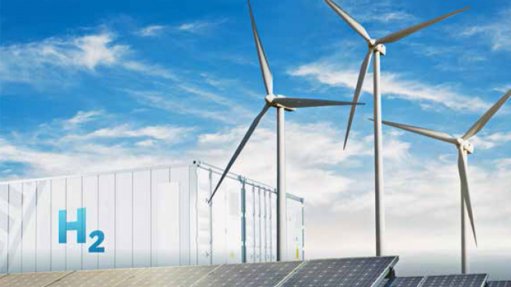
Green-hydrogen aspirant Sasol has set aside R350-million to repurpose an operational electrolyser at Sasolburg, in the Free State, to produce green hydrogen.
CEO Fleetwood Grobler tells Engineering News that the “proof-of-concept project” is likely to be fully operational within 18 to 24 months, producing up to five tonnes a day of green hydrogen and potentially green ammonia.
The long-lead items for the repurposing project were ordered in November last year and Sasol is also moving to procure 60 MW of additional renewable energy to provide electricity for the plant.
Green hydrogen is produced when renewable electricity is used, in an electrolyser, to split water into hydrogen and oxygen.
Grobler reports that Sasol is currently evaluating responses from independent power producers (IPPs) to a recent request for proposals for the additional 60 MW.
The 60 MW is being procured in addition to the 20 MW Sasol is procuring directly from IPPs and the 600 MW being procured jointly with Air Liquide, 200 MW of which is being prioritised for 2023.
In fact, Grobler reports that power purchase agreements are currently being negotiated with several preferred bidders, most of which intend wheeling electricity to Sasol through the Eskom network.
The 60 MW contract, by contrast, will be treated as an embedded generation plant and will be located at Sasolburg.
The company expects to procure a total of 1 200 MW of renewable energy by 2030 as part of its commitment to lower its greenhouse gas emissions by 30% by that date.
The Sasolburg green hydrogen project, meanwhile, is regarded as a modest precursor to a far larger green-hydrogen push by Sasol, which is also leading the prefeasibility study for green hydrogen developments at Boegoebaai, in the Northern Cape.
Sasol is also aiming to leverage the existing Fischer–Tropsch assets at its Secunda complex, in Mpumalanga, to produce sustainable aviation fuel (SAF), again with green hydrogen as a feedstock.
Sasol has partnered with Linde, Enertrag and Navitas to form the LEN Consortium, which aims to bid for the production of SAF under Germany’s H2Global platform. A feasibility study is likely to determine the availability of biomass for feedstock, its cultivation and integration into Secunda’s operation, and arrangements to meet the final H2Global mandatory requirements.
Separately, Sasol is pursuing ten other SAF opportunities and has already entered into two partnership agreements, where its FT technology will be deployed to produce the green fuel.
Grobler says it is premature to provide details but reveals that both projects are located in Europe.
The green hydrogen produced from the Sasolburg facility will not be used to produce SAF, however, as the volumes will be too small to make it economically viable.
Besides the possible production of green ammonia, Sasol is considering other possible markets, mostly related to the transportation sector.